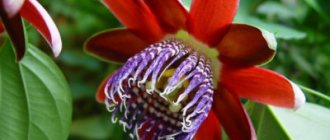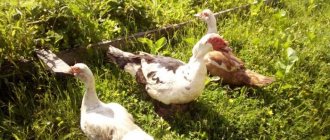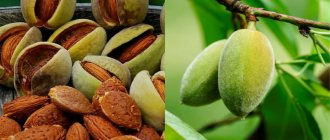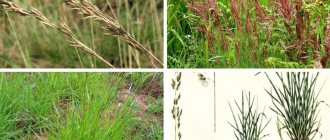Photo
You can visually familiarize yourself with the nightshade “Solanum” or “Potato tree” in the photo below:
Apple and pear trees, and... potato trees bloomed
This glorious ornamental plant, of course, has nothing to do with potatoes - it belongs to the nightshade family. But the flowers and leaves really resemble potato ones. The tree blooms thickly, looks unusual, and therefore makes a special impression. The potato tree, also known as Gentian Nightshade (Lycianthes rantonnetii), is literally strewn with purple-blue flowers with a yellow eye.
Potato tree, or Gentian nightshade (Lycianthes rantonnetii). © FASTILY
There are two varieties of potato trees: climbing and hanging. The shoots reach two meters in length. The leaves are small, oval, “with a fluff”; the flowers are either blue-violet or white with a yellow center. The advantage of the potato tree is its abundant and long flowering - from May to October. The potato tree came to us from South America, so it loves warmth. If you want to grow it in the country, remember: even a light frost will destroy the plant.
To achieve the most magnificent flowering, place the decorative “potatoes” in a place where it will always be in direct sunlight, but protected from wind and rain.
You need to water frequently, especially in hot weather - twice a day, morning and evening. During the flowering period, add liquid flower fertilizer to the water once a week.
Take a closer look at the leaves: if they start to turn yellow, urgently increase the dose of fertilizing, otherwise they will simply fall off.
Potato tree, or Gentian nightshade (Lycianthes rantonnetii)
Flowering “potatoes” grow quickly, so the tops of the shoots can be shortened several times during the season. Where to put it in winter? Place in a cool, bright room and water moderately. The air temperature in the room should not exceed 7 degrees.
To prevent pests and fungi from sticking to the plant, regularly ventilate the room, trying not to chill the flower.
In the summer, help the potato tree - tie it to a trellis, and you are prepared for a wall of solid flowers. Moreover, the flowers are outlandish. And you can tell your surprised neighbors that this is a new, decorative variety of potato blooming...
Home care
Attention! Nightshade berries are poisonous, so be sure to warn your children about this.
Nightshade should be purchased at a time when its berries have not yet acquired a red color. It is better if they are greenish or orange.
Think in advance about where you will place the plant when you bring it home.
Nightshade will feel most comfortable in well-lit, cool living room or bedroom.
In the kitchen, nightshade berries will quickly fall off, since it is constantly warm there.
It is strictly forbidden to place nightshade in a children's room.
Trimming
To maintain the beautiful shape of nightshade, it is necessary every spring , shortening the shoots by a third of their length. This is best done when the berries are already ripe and the leaves begin to turn yellow.
Note! If you pinch those shoots that do not have flowers or buds in the fall, the plant will bush better.
Watering
Watering solanum directly depends on both the time of year and the moisture content of the soil in which the plant is located.
During the growing season, that is, from April to September, nightshade requires abundant watering, which should be carried out immediately after the upper layer of the earth dries . In other months, the plant is in a rest period, so you can water it about once every ten days.
Landing
Note! When planting nightshade, it is necessary to place high-quality drainage at the bottom of the pot to prevent rotting of the root system.
The drainage may consist of fragments of brick or expanded clay, and its thickness should be at least three centimeters.
You can prepare the soil for this plant yourself. To do this, you need to mix equal parts of turf soil with leaf soil and peat, or mix two parts of turf soil with two parts of peat soil, two parts of humus soil and one part of sand.
You can also purchase ready-made soil mixture for indoor plants at your local flower shop.
Transfer
Nightshade is considered an annual plant, but if you regularly prune and replant it, it will delight you for many years.
When young, nightshade needs to be replanted every year. It is held at the end of winter or in the first months of spring.
When the plant reaches five years of age, it can be replanted once every two or three years.
Attention! If you plan to replant solanum, you should not water it in February.
Before replanting, the plant is usually pruned. If it has become larger, choose a larger pot for replanting. Place fresh drainage and soil in the pot and plant the plant there, previously shortened to half its length. Immediately after transplanting, water the nightshade, and after two weeks, start feeding it with fertilizers.
Temperature
During the spring-summer period, solanum should be kept in a room where the air temperature is between eighteen and twenty-six degrees Celsius.
You can take the pot with the plant to the balcony, but it must be protected from direct sunlight and precipitation. In winter and autumn, solanum will feel most comfortable at an air temperature of twelve to fourteen degrees above zero.
Provide him with access to fresh air, but protect him from drafts .
Top dressing
Solanum should be fertilized starting from the end of spring and ending in the beginning of autumn. Liquid fertilizers are most suitable for the plant, which should be applied two to four times a month.
You can purchase any complex liquid fertilizer for flowering indoor plants, for example, “Rainbow” or “Ideal”, and also use fertilizer for tomatoes.
Lighting
Attention! Nightshade loves bright but diffused light.
It will feel best on a windowsill located on the west or east side. If you decide to keep the solanum on the south window, create shade for it between twelve and seventeen hours of the day.
Planting and caring for a potato tree
When choosing a place to plant this unique crop, try to choose sunny and well-lit places. As a soil for planting, it is advisable to use a mixture of sand, turf and leaf soil in proportions of 1:2:1. You can also use humus from a compost pit in combination with chernozem 1 to 1.
Usually one-year-old seedlings are sold; during the first winter they should be kept indoors (basement, greenhouse), since nightshade is very sensitive to low temperatures. In spring, the potato tree can be planted in the sunny part of the plot at a distance of at least 1 m from other plants.
Growing nightshade in the southern regions of Russia
The best place for growing in the Moscow region is considered to be a portable flowerbed or large pot, since the shrub is susceptible to cold. At a stable temperature below 7 degrees Celsius, it can get sick and die, so for the winter it is removed to a greenhouse or indoors.
In the southern zone of Russia it can be grown in open ground. For the winter, plants in pots need to be brought into the house (a basement, balcony, barn will do). If the plant grows in the soil, then before frost, cover the trunk circle with a dense layer of mulch, and the plants themselves with agrofibre.
Reproduction
Growing at home occurs in the following ways:
- To grow nightshade from seeds, you will need leaf soil.
It must be sifted and placed in a container, and the seeds must be distributed over its surface. Sprinkle the seeds on top with a small layer of sand and moisten them a little.After this, cover the container with glass or film and place it in a place where the air temperature will be at least twenty-two degrees.
In a couple of weeks the seeds should sprout. As they grow, they need to be picked twice and then planted in previously prepared soil.
- If you want to propagate nightshade using stem cuttings , do not throw away the branches after spring pruning.
Select the strongest ones and place them in a mixture of sand and peat. You can try rooting nightshade branches in regular sand or vermiculite. As soon as the cuttings send out roots, they will need to be transplanted into separate pots filled with a mixture of two parts turf soil, two parts humus soil and one part sand. Don't forget to put drainage at the bottom of the pots. To make the plant branch faster, pinch it immediately.
How to plant and grow potatoes in a barrel.
There are a lot of ways to plant and grow potatoes: classic under a shovel, growing under straw, according to Mittleider, in beds and in trenches…. At the same time, there is another unusual way - growing potatoes in a barrel. This method of growing potatoes is suitable for small summer cottages, where it is not possible to allocate large beds for potatoes.
How to grow potatoes in a barrel.
Stage 1. Preparing the barrel.
The container can be any - iron, wood, plastic, wicker. We make holes at the bottom of the barrel or, better yet, take a barrel without a bottom. A necessary condition for growing potatoes in a barrel is the absence of stagnant water and good drainage so that the soil can breathe.
Stage 2. Planting potatoes in a barrel.
Pour a layer of compost (rotted humus) mixed with soil 1:1 into the barrel. The height of the soil layer is 10 - 15 cm. Place a layer of potato tubers on it in a circle or in a checkerboard pattern. Fill with a mixture of compost and soil, layer height 10 cm.
Stage 3. Necessary care to grow potatoes in a barrel
As soon as green potato sprouts appear and reach a size of 2-3 cm, they are again covered with a mixture of compost and soil. Do this several times until the barrel is filled with about 1 meter of soil mixture. The most important thing is that the sprouts should not hatch; the green part of the plant is not needed. In this case, the root system will stop developing and a thick stem will stretch all the way to the surface of the earth. The soil in the barrel must be constantly well watered, especially in hot, dry weather.
Feeding potatoes in a barrel is necessary. It could be:
- infusion of ash,
- infusion of organic fertilizers,
- complex fertilizers. IN
The result of such an unusual cultivation of potatoes in a barrel can be amazing. From one cubic meter you can harvest a bag of potatoes.
There are special containers for growing potatoes in a barrel and they are called Potato Barrel. Can be purchased in online stores.
superda4nik.ru
Diseases and pests
If you are faced with a problem such as yellowing and falling of solanum leaves, this indicates that you are keeping the plant in conditions of high temperature and low humidity. Move it to a cooler place and remember to mist regularly.
Insufficient air humidity can cause your pet to be attacked by whiteflies or spider mites . If this happens, remove all affected parts of the plant and treat it with insecticides.
Proper conditions for keeping nightshade and conscientious care for it will ensure your plant a long life. However, do not forget in any case that solanum berries pose a danger to human health when consumed.
LiveInternetLiveInternet
Lycianthes
rantonnetii
Lycianthes rantonnetii (Carrière) Bitter (family Solanaceae) Nightshade Rantonnetii Photo Nightshade Rantonnetii (Solanum rantonnetii) is no longer a nightshade and is classified in another family called Lycianthes rantonnetii. This species originates from Paraguay and Argentina. It was brought to France in 1868. Bears the name of the French gardener Rantonnette, noted for his great work in acclimatizing plants on the Côte d'Azur of France. Its other names are Paraguayan nightshade, Blue potato tree, Gentian nightshade.
Lycianthes
rantonnetii
Photo-https://www.plantarium.ru
Solanum rantonnetii - Rantonneti nightshade. Potato tree, Gentian nightshade is a beautiful, constantly flowering bush literally strewn with violet-blue flowers with a yellow eye. The flowers and leaves really resemble potato ones. The tree blooms thickly, looks unusual, and therefore makes a special bright impression. After flowering, small red berries appear on the bush. Potato tree berries are very poisonous and contain the alkaloid solanine! They can cause severe poisoning and have a paralytic effect. In nature, there are many types of nightshades, among which there are both ornamental shrubs with poisonous berries and fruit shrubs with edible ones.
Bittersweet nightshade (Solanum dulcamara) is common in Europe and North Africa; in central Russia it grows in meadows and floodplains. It is a deciduous climbing subshrub up to 2.5-3 m tall, with woody stems at the base, bare or drooping with sparse appressed hairs. The leaves are predominantly tripartite, 4-10 cm long and 2.5-6 cm wide, rarely pubescent or glabrous, on petioles 1-3 cm long. The flowers are purple, less often pink or white, similar to potato flowers, five-membered, 12-18 mm in diameter, with narrow lobes bent back, less than 1 cm long, at the base with green white-edged spots, collected in drooping panicles of 6-25 or more flowers. The fruits are bright red, less often greenish-yellow, ovoid, with a pointed tip, berries up to 1.5 cm long, with numerous seeds, poisonous. Blooms in June-July, bears fruit in July-October. There is a variegated form, Variegata, which has leaves with an uneven white border.
Until recently, it was not widespread in culture - few people found beauty in “potato” leaves and flowers. The French Marquise de Pompadour, who loved to pin a boutonniere of potato flowers to her dress and contributed greatly to how the fate of this culture ultimately developed, would definitely not agree with this opinion.
Potato
tree
Tolerates drought and extreme heat. It grows very quickly, undemanding to soil. To keep the bush compact, it must be pruned regularly. It blooms especially profusely in summer and autumn. It will delight its owners with abundant flowering year after year. Wintering in a light or dark room with a temperature of about +8, +10 degrees. It can grow as a bush or can form a beautiful standard tree. To do this, in the summer, the tops of new shoots are pinched every month. In spring, the crown is trimmed to the desired shape and size. Pruning can be quite drastic. If the leaves begin to turn yellow, urgently increase the dose of fertilizing, otherwise they will simply fall off.
When there is a lack of moisture, plants drop their leaves and shed buds and flowers. Stagnation of water at the bottom of the pot can cause rotting of the roots and yellowing of the leaves.
In a room that is too warm, even with sufficient watering, the berries may shrink and the leaves may wither and fall off.
The main enemy is late blight. If round yellow spots appear on the leaves, the plant is infected with the tobacco mosaic virus
The nightshade genus (Solanum) is the largest in the nightshade family (Solanaceae) and one of the largest among the angiosperms, numbering about 1,700 plant species. Decorative nightshades
Nightshade (Solanum pseudo-capsicum) probably originates from the island of Madeira. In nature, it is an evergreen shrub up to 1 m tall. The shoots are glabrous, the leaves are on short petioles, lanceolate or oblong, entire, often with slightly wavy edges, pointed or obtuse at the apex, wedge-shaped at the base, with distinct venation, light green and shiny above. The flowers are unattractive, star-shaped, small, white, solitary or collected in several. The fruits are very decorative spherical berries, 12-18 mm in diameter, bright red, rarely yellow, resembling small tomatoes, but poisonous. In English-speaking countries, the plant is called Jerusalem cherry, Christmas cherry, because at Christmas it is densely strewn with fruits.
The plant is most decorative during the fruiting period, which lasts several months and occurs in the summer-autumn period. Usually, a plant that bears fruit is replaced with a new one, that is, it is used as an annual. Renew by seeds or cuttings. For growing in pots, a dwarf form (Solanum pseudo-capsicum var. nanum) up to 30 cm in height is used, but more often a hybrid form with orange fruits and wavy leaf venation is used.
Passiflora
edulis
The tropical passionflower vine has about 400 species. Its homeland is South America. The most valuable garden species is edible passionflower (Passiflora edulis) - with a herbaceous, partially woody stem. The complex structure of five bracts, sepals and petals framed by long wavy stamens looks very impressive, resembling a voluminous star in its shape. The bizarre shape is characteristic of all varieties of the plant, but the color of the passionflower flower, the size and color of the fruit, even its taste are unique for each variety. Thus, there is an incredible variety of colors within one species.
Blue
passionflower (
Passiflora caerulea
)
Due to the original shape of the flowers, it is often called the cavalry star, the order-bearing liana. The Spaniards associate this flower with the crown of thorns, and the Japanese associate it with the clock. This plant is also called the “flower of the Lord’s passion,” which is associated with an ancient legend according to which the vine symbolized the suffering of Christ. In Latin it was called passioflos, which translates as flower of suffering.
Over six hundred species of this charming plant are known, and there are both herbaceous annuals and evergreen shrubs with tenacious branches climbing tree trunks. The amazing diversity of the passion flower is due to its prevalence. Passionflower can be found in the virgin tropical forests of South and North America, on the shores of Australia, Polynesia, Madagascar and Asia.
Sometimes passionflower is called by the name of the edible fruits of some of its species - granadilla and passion fruit. Humanity has known about the healing properties of the plant since time immemorial - the Incas drank passionflower tea, since the main property of the plant is its calming (sedative) effect. Passionflower preparations improve the quality and duration of sleep without leaving any discomfort upon awakening. But in addition to the sedative effect, passionflower has anti-inflammatory, antispasmodic, anticonvulsant and analgesic properties, increases performance and potency, improves memory, relieves irritability and nervousness.
The first mentions by Europeans date back to 1552, when the physician Martin de la Cruz described the medicinal plants used by the Aztecs in his herbal book.
The Aztecs used it for urinary retention, broken bones and bruises. At the beginning of the 16th century, it appeared in Europe, where it was used to treat insomnia and pain. But it aroused even greater interest as an ornamental plant in botanical gardens, and was gradually forgotten as a medicinal plant. But in North American countries in the 19th-20th centuries, it was one of the most popular medicinal plants. Indications for use were sleep disorders, seizures, nervousness, and even epilepsy. In Europe, serious attention was paid to it only after Gerhard Madaus published detailed information on pharmacological action and use in his “Directory of Natural Remedies” in 1938. Medicinal properties of passionflower But talking only about the medicinal properties of passionflower means not saying everything. The aromatic, sweet and sour spherical or ovoid fruits of these plants with very juicy pulp are also of great value. In total there are about 60 species of passion flowers with edible fruits. And the first among them is edible passionflower (Passiflora edulis). Edible passionflower is better known to us as passion fruit - an overseas fruit that, together with peach, is added to yoghurts. It contains organic acids (mainly citric), vitamin C (20-50 mg%), carotenoids. Passion fruit contains vitamins C, E, B1, B2, B3, A, K, calcium, magnesium, iron, fluorine, etc. Passion fruit (passion flower) is a record holder for the content of leucopene, which prevents the development of prostate cancer.
Louis Van Houtte, Flore de Serres et des Jardins de l'Europe Botanical Prints 1851.
Jasmine
(
Jasminum
L.)
The genus Jasmine (Jasminum) unites about 200 species of deciduous and evergreen woody vines and shrubs. Jasmine is an evergreen shrub with climbing stems and flowers collected in star-shaped inflorescences. Jasmine leaves can be simple, trifoliate or odd-pinnate, opposite or alternate. Jasmine (Jasminum) is a genus of tropical and subtropical shrubs and vines from the olive family (Oleaceae).
India, the region of Kashmir, is considered the birthplace of jasmine. An ancient Indian legend tells the story of Princess Jasmine, who fell madly in love with the Sun God (Surya Deva). Unfortunately, the beauty's love remained unrequited. Jasmine came to Europe during Arab rule and, after ousting the Moors, began to spread as an ornamental plant throughout the Mediterranean.
Jasmine began to be cultivated for its essential oil in the 19th century in France, and very soon became an indispensable component of the most prestigious perfumes. In perfumery and aromatherapy, two types of jasmine are most often used: jasmine officinale L. and jasmine sambac. Jasmine sambac is most common in Asia - in China it is used to flavor the highest grades of tea.
Bitter orange (orange) is one of the most amazing plants in terms of obtaining essential oil. Bitter orange essential oil is obtained from the peel of the fruit, neroli oil from the flowers, and petitgrain oil from the leaves and twigs.
The orange tree became known to the Arabs at the turn of the 9th-10th centuries. Despite the fact that oriental sweets made from orange fruit were a favorite delicacy, bitter orange was more valued as a medicine. Avicenna included it in many of his potions.
There is an assumption that already in those distant times, a fragrant liquid was obtained from the fragrant flowers of “nareng”, as the Arabs called the bitter orange. In the 12th century, the fragrant essence was named “neroli” by Europeans in honor of Anna Maria de la Tremoile, Princess of Nerola, who was very fond of the exquisite aroma of bitter orange and even introduced the fashion for perfumes made from the flowers of this plant.
In the Middle Ages, bitter orange began to be grown in Spain, Italy, and France. The zest of the fruit of the orange tree was used for stomach diseases, and orange blossom oil was considered the best sedative.
Presunto ritratto di Marie-Anne de la Tremoille (1642-1722) principessa di.
Anna Maria de la Tremoile, Duchess of Orsini, was from the small Italian town of Nerola, located in the outskirts of Rome. Hence the name - neroli, in honor of the princess from Nerola. The famous beauty loved the scent of orange tree flowers and scented her clothes and gloves with them, and also added them to her bath and used them instead of perfume. It was Princess Neroli who was the first to obtain neroli essential oil from flowers using steam distillation. This happened at the end of the 17th century. The aroma of the oil turned out to be delicate and sensual, loved by many and became popular. Since then and to this day, neroli oil has been obtained from the flowers of the bitter orange - bitter orange.
Post series "Plant World":
Part 1 - These amazing plants Part 2 - These amazing plants - 2 ... Part 10 - Platycodon Part 11 - Caesalpinia gilliesii Part 12 - My encyclopedia of Montenegrin plants - 7 Part 13 - New resistant varieties varieties of petunia Part 14 - Delightful petunia and its varieties ... Part 28 - My encyclopedia of Montenegrin plants - 14 Part 29 - My encyclopedia of Montenegrin plants - 16 Part 30 - Admire and don’t touch!
Series of messages "Encyclopedia":
Part 1 - My encyclopedia of Montenegrin plants - 1 Part 2 - My encyclopedia of Montenegrin plants - 2 ... Part 6 - My encyclopedia of Montenegrin plants - 6 Part 7 - Caesalpinia gilliesii Part 8 - My encyclopedia of Montenegrin plants - 7 Part 9 - New varieties of resistant varieties of petunia Part 10 - Delightful petunia and its varieties ... Part 19 - My encyclopedia of Montenegrin plants -15 Part 20 - My encyclopedia of Montenegrin plants - 16 Part 21 - Admire and don’t touch!
The use of black nightshade in folk medicine
In folk medicine, nightshade is eaten as a sweet medicine, tinctures are made, and teas are drunk. For various pains, tea is made from nightshade leaves. 1 tablespoon per glass of boiling water is infused for 4 hours, cooled and taken half a glass 2 times a day. Increases the desire to urinate - this is a normal reaction of the body to nightshade. If you have skin problems and this is due to age-related changes or nutritional interruptions, then you should take a decoction of nightshade leaves for 10 days in a row three times a day. During this time, itching and burning on the skin will disappear, the balance of fat cell secretion will be restored, and the skin will acquire an even shade.
Nightshade berries brewed in boiling water will help remove kidney stones, problems with the bladder, colic and intestines. This mild decoction will help put the digestive system in order during the first day of use. For prevention, you should take the decoction for a week in the morning. People suffering from hypertension can eat ripe nightshade berries in unlimited quantities. The accumulation in the body of the necessary substances for recovery will not affect the appearance and health in general. Boil nightshade berries with sugar, strain into a separate bowl, leave to cool for several hours and then boil thoroughly, gradually adding sugar until completely thickened. This way you will get a delicious and nutritious nightshade jam.
Nightshade
soil mixture No. 2, specialized soil, universal soil
scattered sun rays
Nightshade (Solanum) is a genus of plants in the Solanaceae family, which includes more than 900 species, including eggplant and potato. The first plants were brought from Brazil in the mid-19th century.











